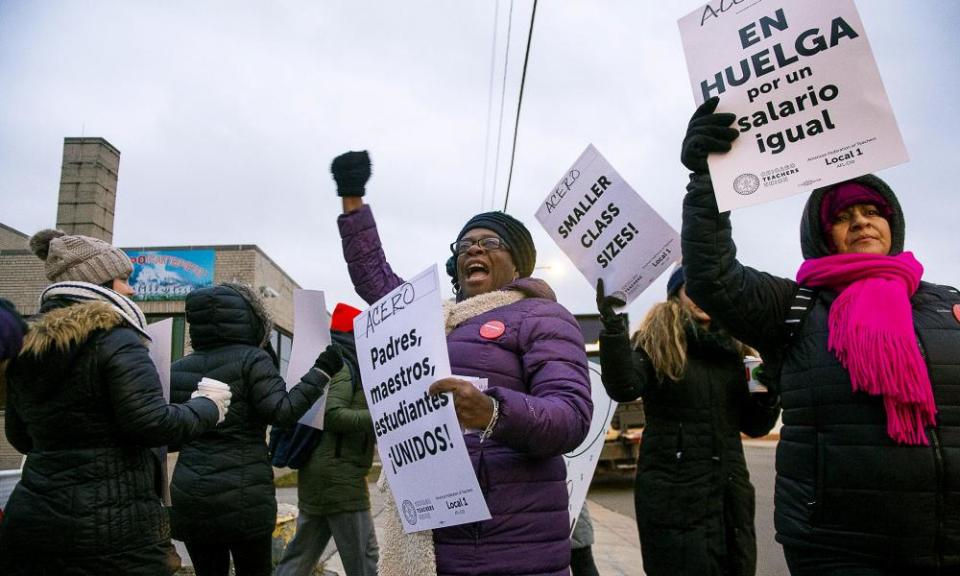Why a historic strike by Chicago charter school teachers matters
Teachers across the US learned this year they can push back by withholding their labor. The spread of Acero’s example to other charters is a matter of ‘when’, not ‘if’

On a freezing picket line Friday on Chicago’s north-west side, Elly Oldendorf, a second-grade teacher at Carlos Fuentes elementary in the Acero charter school network, was on day four of a strike. Bundled in winter gear, her coworkers behind her chanting about school funding to the tune of a Rihanna song, Oldendorf told me a story.
“The first day of the strike,” she said, a teacher from a different, non-union charter school pulled her car up to the picket line and delivered coffee. She told the strikers: “‘I am so inspired by what you guys are doing.’”
It’s a story and a strike that should worry the ultra-rich Wall Street investor and Silicon Valley entrepreneur-types who have taken aim at public education in recent years, looking to turn education into a commodity – especially through the expansion of non-union charter schools – while trying to starve the public education system.
Acero charter teachers went on the first charter school teacher strike in US history last week. They declared victory, on Sunday claiming a number of key concessions from school management. It seems unlikely that the Acero teachers successfully taking on their bosses, the billionaire-backed corporate education reform model, and the broader context of austerity in America through striking will stay confined to Chicago.
For decades, the wealthy have tried very hard to turn public schools into profit-making enterprises. Charter schools are a central mechanism for that privatization agenda, mainly because unlike public schools, few charters are unionized. No unions means no contracts mandating raises for time worked and education completed, decent pensions and healthcare, due process for firing teachers, and no organized power for teachers – keeping teacher compensation low and eliminating a key barrier, organized teachers, to using the education system to get rich.
Acero, formerly known as Uno, is one of Chicago’s largest charter school chains, with more than a dozen schools and over 7,000 students. Its former CEO, Juan Rangel, was a close ally of privatization enthusiast Chicago mayor Rahm Emanuel but saw a rapid fall from grace after Uno’s “insider contracts, nepotistic hires and political cronyism” were exposed in the Chicago Sun-Times. Shortly after the scandal broke, he resigned in disgrace, and Uno teachers unionized. The network rebranded as Acero.
The unionization shouldn’t have been a surprise. The Chicago Teachers Union claims that Acero teachers make 30% less than their peers in district-run schools. Other Chicago charter schools have similar salary disparities – a 2016 report on the Noble charter network, for example, found that Noble teachers made $16,000 less a year than district-run schools.
The strike will be a powerful example for other charter teachers around the country, whose conditions aren’t much different from Acero’s
Wage parity with district-run schools was a central demand at the bargaining table. Also demanded by Acero teachers were smaller class sizes (the CTU and management agreed to lower the cap on class sizes from 32 to 30) and strong language to keep Immigration and Customs Enforcement (Ice) officials out of the mostly Latino schools.
The strike will be a powerful example for other charter teachers around the country, whose conditions aren’t much different from Acero’s. A 2016-2017 study found only 11% of charter educators are unionized. Nationally, charter teachers earn far less than traditional public school teachers. If other charter teachers look at the Acero example and see a way to close their pay gap between regular public schools and wrest some power out of the hands of charter operators, they could embrace teachers unions and militant actions like strikes. Without such a pliant, cheap workforce, education privatizers could lose their incentive to keep spreading charters.
Acero’s strike also shouldn’t have been a surprise. The CTU struck in 2012 and 2016. And 2018 was the year of the teachers strike. West Virginia teachers kicked things off in February with illegal strikes highlighting low teacher pay and abysmal classroom conditions. Other states including Oklahoma, Arizona, North Carolina and Kentucky soon joined the “red state revolt”.
These strikes were often unsanctioned and occasionally in defiance of both official union leadership and the law – differing from cities like Chicago as well as Los Angeles and Oakland, where teachers strikes are also brewing. In those cities, public-sector workers have stronger collective bargaining rights and thus more opportunities to improve work conditions at the bargaining table. But their unions are led by teachers guided by a rank and file-led, community-focused, “class-struggle” vision of teacher unionism that includes a strong belief in the power of strikes to fight austerity. In both cases, teachers have fought against public education budget cuts at a time of upward redistribution of wealth, hollowing out of public goods and assault by a plundering billionaire class – and won.
Public school teachers across America have learned this year that they can beat back attacks by Republicans and center-left Democrats through withholding their labor. Acero teachers just showed that charter educators, too, can stand up to the billionaire-backed model. The spread of their example to other charters around the country is a matter of “when”, not “if”.
Micah Uetricht is the managing editor of Jacobin magazine and the author of Strike for America: Chicago Teachers Against Austerity

